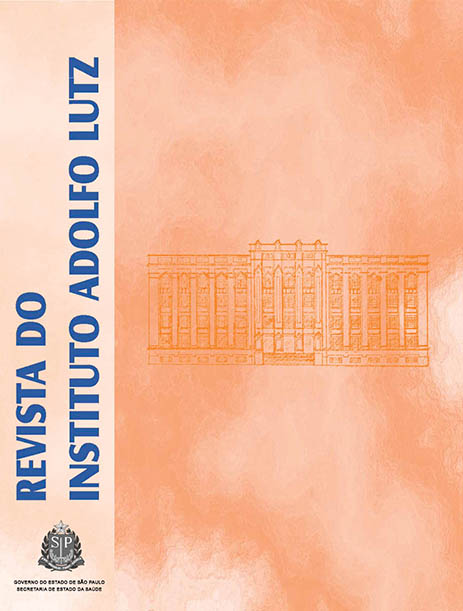Abstract
The present study aimed at evaluating the quality of ricotta cheeses marketed in the region of Campinas, SP, and to characterize the pathogenic potential of the isolated Listeria monocytogenes strains. Of 45 analyzed samples, 46.7% (21/45) did not comply with the Brazilian microbiological standard established. Most of the evaluated samples showed the microorganisms counts above those established by the regulation, that is, 46.7% for thermotolerant coliforms, 2.2% for coagulase-positive staphylococci, and 6.7% for Listeria monocytogenes. No Salmonella was isolated from these samples. It was evidenced the ocurrence of Listeria monocytogenes strains, with virulence genes acta type 4 and hly type 1, and classified as lineage I, which indicate the pathogenic potential for human. This study evidenced that this class of product deserves more attention from the scientific community, and also from manufacturing sector and sanitary surveillance bureau, improving the products quality, and consequently the consumer safety.
References
1. Kosikowski FV, Mistry VV. Soft Italian Cheese-Mozzarella and Ricotta. Cheese and Fermented Milk Foods: Volume I: Origins and Principles. 3ª ed. Virginia; 1999.
2. Hough G, Puglieso ML, Sanchhez R, Silva MO. Sensory and Microbiological Shelf-Life of a Commercial Ricotta Cheese. J Dairy Sci. 1999;82(3):454-9.
3. Brasil. Ministério da Saúde. Resolução RDC nº 12, de 02 de janeiro de 2001. Aprova o Regulamento Técnico sobre Padrões Microbiológicos para Alimentos. Diário Oficial da Republica Federativa do Brasil. Brasília, DF, 10 jan. 2001. Seção 1, nº7-E. p.45-53. Agradecimentos À FAPESP pelo auxílio à Pesquisa e à CAPES pela bolsa de estudo concedida.
4. Raimundo IC. Avaliação microbiológica de amostras de ricotas comercializadas no município de Alfenas [dissertação de mestrado]. Lavras (MG): Universidade Federal de Lavras; 2004.
5. Beltrán JFN, Neto AC, Pires EMF, Stamford TLM. Avaliação microbiológica de refeições servidas por empresas aéreas nacionais. Hig Aliment. 1999;59(13):49-56.
6. Cossedu AM, Santi EPL, Mazzette R, Fresi A, Lai G. Ricotta bovina fresca confezionata: caratteristiche microbiologiche di interesse igienico-sanitario. Latte. 1997;7: 76-81.
7. Food and Drug Association - FDA. Enforcement report. [acesso 2009 Set 09]. Disponível em: [www.fda.gov/bbs/topics/enforce/2003/ENF00797.html].
8. Ryser ET, Marth EH. Listeria, listeriosis and food safety. 2ªed. New York: Marcel Dekker; 1999.
9. Jay, JM. Microbiologia de alimentos. 6ªed. Porto Alegre: Artmed; 2008.
10. Hofer E, Nascimento RS, Oliveira MA. Meningite por Listeria monocytogenes. Relato de casos em pacientes do Distrito Federal. Rev Soc Bras Med Trop. 1998;31:173-7.
11. Centers for Diseases Control and Prevention. Outbreak of listeriosis associated with homemade Mexican-style cheese – North Caroline, October 2000 - January 2001. MMWR - Morb Mortal Wkly Rep. 2001;50(26):560-2.
12. Schwab JP, Edelweiss MIA. Identificação imuno-histoquímica de Listeria monocytogenes em placentas fixadas em formol e embebidas em parafina. Rev Bras Ginecol Obstet. 2003;25(7):501-5.
13. Kornacki JL, Johnson JL. Enterobacteriaceae, Coliforms, and Escherichia coli as Quality and Safety Indicators. In: American Public Health Association-APHA. Compendium of Methods for the Microbiological Examination of Foods; 2001; Washington, US; p.69-82.
14. Lancette GA, Bennett RW. Staphylococcus aureus and Staphylococcal Enterotoxins. In: American Public Health Association-APHA. Compendium of Methods for the Microbiological Examination of Foods; 2001; Washington, US; p. 387-403.
15. Rheinbaben KE, Hadlok RM. Rapid distiction between micrococci and staphylococci with furazolidone agars. Antonie van Leeuwenhoek. 1991;47:41-51.
16. Andrews HW, Flowers RS, Silikers J, Bailey SJ. Salmonella. In: American Public Health Association-APHA. Compendium of Methods for the Microbiological Examination of Foods; 2001; Washington, US; p.357-80.
17. Beuchat LR, Cousin MA. Molds and Yeast. In: American Public Health Association-APHA. Compendium of Methods for the Microbiological Examination of Foods; 2001; Washington, US;p.209-13.
18. Pagotto F, Daley E, Farber J, Warburton D. Isolation of Listeria monocytogenes from all food environmental samples. In: CANADA. Health Products Food Branch. Compendium of analytical methods: laboratory procedures of microbiological analytical of foods [MFHPB 30]. [acesso 2009 Fev 02]. Disponível em: [www.hc-sc.gc.ca/food-aliment].
19. Wiedmann M, Bruce JL, Keating C, Johnson AE, Mc Donough PL, Batt CA. Ribotypes and virulence gene polymorphisms suggets three distinct Listeria monocytogenes lineages with difference in pathogenic potencial. Infect Immun.1997;65 (7): 2707-16.
20. Tebaldi VMR, Ramalho GCA, Oliveira TLC, Schwan RF, Piccoli RH. Alteração microbiológica de ricota durante a vida de prateleira. Congresso Brasileiro de Microbiologia [CD-ROM]. Santos: Anais Sociedade Brasileira de Microbiologia.[Resumo 23]; 2005.
21. Brindani F, Pizzin G, Bonardi S, Bacci C. Traditional cows' milk ricotta produced in the Parmigiano-Reggiano cheese area: assessment of the microbiological profile. Annali Fac Med Vet. 2002;21:283-92.
22. Landgraf M, Gonçalves JÁ, Falcão DP. Surto de toxinfecção alimentar por Salmonella Bredeney. Rev Saúde Públ. 1985;19:92-3.
23. Baker DF, Kraa E, Corbett SJ. A multi-state outbreak of Salmonella bredeney food poisoning: a case control study. Aust N Z J Public Health. 1998;22(5):552-5.
24. Normano G, Firinu A, Mula G, Dambrosio A, Poggiu A, Descastelli L, et al. Coagulase-positive Staphylococci and Staphylcoccus aureus in food products marketed in Italy. Int J Food Microbiol. 2005;98:73-9.
25. Tompikin RB. Control of Listeria monocytogenes in the food - processing environment. J Food Prot. 2002;65(4):709-25.
26. Kabuki DY, Kuaye AY, Wiedmann M, Boor KJ. Molecular subtyping and tracking of Listeria monocytogenes in latin-style fresh-cheese processing plants. J Dairy Sci. 2004;87:2803-12.
27. Rocha JAK. Estudo da presença de Listeria monocytogenes e Bacillus cereus em indústria processadora de queijo Minas frescal [dissertação de mestrado]. Campinas (SP): Universidade Estadual de Campinas; 2004.
28. Brito JRF, Santos EMP, Arcuri EF, Lange CC, Brito MAVP, Souza GN, et al. Retail Survey of Brazilian Milk and Minas Frescal Cheese and a Contaminated Dairy Plant To Establish Prevalence, Relatedness, and Sources of Listeria monocytogenes Isolates. Appl and Environ Microbiol. 2008;74(15):4954-61.
29. Kabuki DY, Souza RM, Kuaye AY. Caracterização genética de Listeria monocytogenes isoladas de alimentos. In: XX Congresso Brasileiro de Ciência e Tecnologia de Alimentos; 2006; Curitiba.
30. Carminati D, Bellini E, Perrone A, Neviani E, Mucchetti G. Traditional ricotta cheese: survey of the microbiological quality and its shelf life. Industrie Aliment. 2002;41:549-55.

This work is licensed under a Creative Commons Attribution 4.0 International License.
Copyright (c) 2011 Instituto Adolfo Lutz Journal
